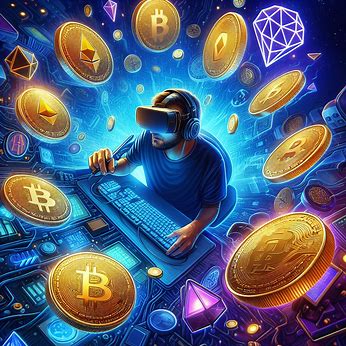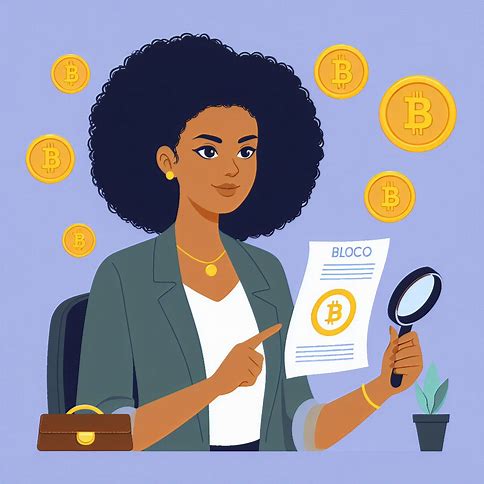One way to get started with crypto trading without risking real money is through crypto paper trading.
What is Crypto Paper Trading?
Crypto paper trading is also known as virtual trading or demo trading. It is the practice of simulating crypto trades without using real money. It allows you to trade with virtual funds in a risk-free environment that mirrors real market conditions.
Most paper trading platforms provide users with a virtual balance, often equivalent to a substantial amount of USD or BTC. You can then use this virtual balance to place simulated trades, testing your strategies and getting a feel for the market without the pressure of potential financial losses.
Related: Best Crypto Paper Trading Apps in 2024
Paper trading platforms typically offer the same features as real trading platforms, including real-time market data, charting tools, and the ability to place various types of orders (e.g., market, limit, stop-loss). This allows you to experience the full trading process, from analysis to execution, without putting real money on the line.
Benefits of Crypto Paper Trading
Risk-free learning:
The most significant advantage of paper trading is that it allows you to learn and practice trading strategies without risking real money. You can make mistakes, try out different approaches, and refine your skills in a safe environment.
Testing strategies:
Paper trading is an excellent way to backtest and forward-test trading strategies. You can see how your strategies would have performed in past market conditions and get a sense of their potential profitability and risk profile.
Building confidence:
Trading with real money can be emotionally challenging, especially for new traders. Paper trading helps you build confidence in your abilities and develop the psychological resilience needed to handle the ups and downs of the market.
Familiarization with trading platforms:
Different exchanges and trading platforms can have varying interfaces and features. Paper trading allows you to familiarize yourself with a platform’s layout, order types, and charting tools before committing real funds.
No costs:
Unlike real trading, where you may incur fees for transactions, deposits, and withdrawals, paper trading is typically free. This allows you to focus on learning and practicing without worrying about costs eating into your virtual profits.
How to Get Started with Crypto Paper Trading
Choose a paper trading platform:
Many cryptocurrency exchanges, such as Binance, Coinbase, and Kraken, offer paper trading features. There are also standalone paper trading platforms like CryptoHopper and CryptoParrot.
Create an account:
Sign up for an account on your chosen platform. You may need to provide some basic information, but since you’re not dealing with real money, the registration process is usually simpler than for real trading accounts.
Familiarize yourself with the platform:
Take some time to explore the platform’s interface, features, and tools. Most platforms offer tutorials or guides to help you get started.
Develop a trading plan:
Before you start placing trades, it’s important to have a clear trading plan. This should include your goals, risk tolerance, strategies, and the markets you want to trade.
Start paper trading:
With your virtual balance, start placing simulated trades based on your trading plan. Keep detailed records of your trades, including entry and exit points, position sizes, and the reasoning behind each trade.
Analyze your performance:
Regularly review your paper trading results to identify what’s working and what needs improvement. Look for patterns in your successful and unsuccessful trades, and use this insight to refine your strategies.
Tips for Effective Crypto Paper Trading
Treat it like real trading:
Approach paper trading with the same seriousness and discipline as you would real trading. This means following your trading plan, managing risk, and not letting emotions dictate your decisions.
Use realistic position sizes:
When paper trading, it can be tempting to make oversized trades since there’s no real money at risk. However, this can lead to unrealistic expectations and skew your performance. Use position sizes that align with what you’d use in real trading based on your actual capital.
Incorporate risk management:
Just because you’re not risking real money doesn’t mean you should ignore risk management. Practice setting stop-losses, taking profits, and diversifying your virtual portfolio as you would in real trading.
Stay up-to-date with market news:
Successful trading requires staying informed about market developments, news, and events that can impact prices. While paper trading, make it a habit to follow reputable crypto news sources and analyze how news events affect your virtual positions.
Engage with the community:
Many paper trading platforms have user communities where you can connect with other traders, share insights, and learn from more experienced practitioners. Don’t be afraid to ask questions and participate in discussions.
Transition gradually to real trading:
When you feel confident in your paper trading performance, consider transitioning to real trading gradually. Start with small position sizes and increase your exposure as you gain more experience and comfort with real market conditions.
Limitations of Crypto Paper Trading
Absence of real emotions:
Paper trading doesn’t fully replicate the emotional aspects of real trading, such as the fear of losing money or the excitement of making profits. These emotions can significantly impact decision-making in real trading scenarios.
Slippage and liquidity:
Paper trading platforms may not always accurately simulate the slippage and liquidity conditions of real markets, especially during high-volatility periods. This means that the prices and fills you get in paper trading may differ from what you’d experience with real trades.
No real market impact:
In paper trading, your simulated trades don’t impact the real market. In contrast, your real trades, especially if they’re large, can move prices and affect market dynamics.
Limited accountability:
Since paper trading doesn’t involve real money, there may be less accountability for your decisions. This can lead to taking excessive risks or deviating from your trading plan, behaviors that can be detrimental in real trading.
Other Methods To Learn Crypto Trading
Educational courses and resources:
There are numerous online courses, tutorials, books, and websites dedicated to teaching crypto trading strategies and concepts.
Backtesting:
Backtesting involves testing your trading strategies against historical market data to gauge their effectiveness. Many trading platforms offer backtesting tools.
Observing real traders:
Following and learning from experienced traders, whether through social media, trading communities, or mentorship programs, can provide valuable insights into real-world trading practices.
Crypto paper trading is a great way to start and to get the most out of paper trading, treat it like real trading, use realistic position sizes, practice risk management, stay informed about the market, and engage with the trading community.
Frequently Asked Questions
Is paper trading completely free?
In most cases, yes. Most crypto exchanges and trading platforms offer paper trading features at no cost. However, some advanced paper trading platforms may charge a fee for premium features or extended use.
Can I paper trade any cryptocurrency?
Most paper trading platforms support a wide range of cryptocurrencies, including major ones like Bitcoin, Ethereum, and Litecoin, as well as many altcoins. However, the exact selection may vary by platform, so check what’s available before signing up.
How long should I paper trade before switching to real trading?
There’s no set timeline, as it depends on your individual learning pace and comfort level. Some traders may feel ready after a few weeks, while others may paper trade for months. The key is to trade until you consistently make profitable decisions and feel confident in your strategies.
Can I paper trade 24/7, just like in the real crypto market?
Yes, most paper trading platforms operate 24/7, mirroring the round-the-clock nature of real crypto markets. This allows you to practice trading at any time and experience different market conditions.
Will my paper trading performance exactly match my real trading results?
Not necessarily. Paper trading simulates market conditions, but it can’t perfectly replicate factors like emotions, slippage, and liquidity that can impact real trading results. Use paper trading as a learning tool, but be prepared for some differences when transitioning to real trading.
Can I practice margin trading or futures trading with paper trading?
Some paper trading platforms do offer simulated margin and futures trading, allowing you to practice these more advanced trading strategies. However, this feature isn’t universal, so check the capabilities of your chosen platform.
Are there any risks to paper trading?
The main risk of paper trading is developing unrealistic expectations or bad habits that don’t translate well to real trading. To mitigate this, treat paper trading as seriously as you would real trading, and be aware of its limitations.
Can I share my paper trading results with others?
Many paper trading platforms allow you to share your virtual portfolio and trade history with others. This can be a great way to get feedback, learn from others, and even engage in friendly competitions. Just be sure to protect your personal information when sharing online.
Are there any tax implications to paper trading?
No, since you’re not making real trades or generating actual profits, paper trading has no tax implications. However, once you start real trading, be sure to keep detailed records and consult with a tax professional to ensure compliance with your local regulations.
Can paper trading help me learn technical analysis?
Absolutely. Paper trading platforms typically offer the same charting tools and technical indicators as real trading platforms. By practicing your technical analysis skills in a risk-free environment, you can refine your strategies and build your confidence before applying them to real markets.










